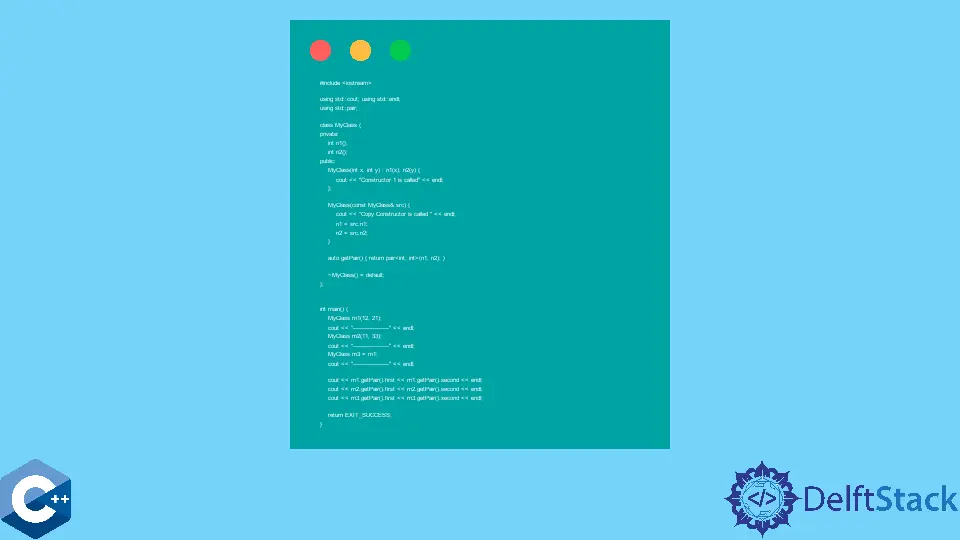在 C++ 中使用复制构造函数

本文解释了如何在 C++ 中使用复制构造函数的几种方法。
在 C++ 中使用复制构造函数从另一个相同类型的对象初始化一个对象
类中有几个操作统称为复制控制。这些操作定义了如何复制、移动、分配或销毁给定类类型的对象。在本文中,我们将只关注复制构造函数和复制赋值。
复制构造函数通过复制作为引用传递的参数的值来初始化对象(它通常作为 const 引用传递)。该类不需要像任何其他复制控制操作一样定义复制构造函数,因为编译器会自动为未定义的操作定义合成操作。不过,通常后者可能会导致问题。合成复制构造函数将参数对象的每个成员复制到正在创建的对象。可能有一些其他类类型的成员,它们被它们的复制构造函数复制。相比之下,内置类型对象是直接复制的。
以下示例代码演示了 MyClass 的复制构造函数的行为,它采用复制构造函数的唯一必需参数,然后初始化数据成员。另一方面,复制构造函数可以有额外的参数,这些参数必须是可选的并且有默认值。
当第一次创建 MyClass 类型的对象时,会调用默认构造函数;但是,如果我们将 m1 分配给新创建的 m3 变量,则会调用复制构造函数。后一种操作也称为复制初始化,它可以使用复制构造函数或移动构造函数(在另一篇文章中讨论)。
#include <iostream>
using std::cout;
using std::endl;
using std::pair;
class MyClass {
private:
int n1{};
int n2{};
public:
MyClass(int x, int y) : n1(x), n2(y) {
cout << "Constructor 1 is called" << endl;
};
MyClass(const MyClass& src) {
cout << "Copy Constructor is called " << endl;
n1 = src.n1;
n2 = src.n2;
}
auto getPair() { return pair<int, int>(n1, n2); }
~MyClass() = default;
};
int main() {
MyClass m1(12, 21);
cout << "------------------" << endl;
MyClass m2(11, 33);
cout << "------------------" << endl;
MyClass m3 = m1;
cout << "------------------" << endl;
cout << m1.getPair().first << m1.getPair().second << endl;
cout << m2.getPair().first << m2.getPair().second << endl;
cout << m3.getPair().first << m3.getPair().second << endl;
return EXIT_SUCCESS;
}
输出:
Constructor 1 is called
------------------
Constructor 1 is called
------------------
Copy Constructor is called
------------------
1221
1133
1221
使用复制赋值运算符在 C++ 中定义对象的赋值运算符重载
复制赋值运算符定义了如何分配相同类型的对象。如果用户没有明确定义它,编译器也会综合这个操作。复制赋值的描述类似于其他运算符重载函数。它采用与类相同类型的参数,通常返回对左侧操作数的引用。复制赋值运算符必须定义为成员函数。
下一个代码片段为 MyClass 添加复制赋值运算符,并在将 m2 对象分配给 m1 时调用它。
#include <iostream>
using std::cout;
using std::endl;
using std::pair;
class MyClass {
private:
int n1{};
int n2{};
public:
MyClass(int x, int y) : n1(x), n2(y) {
cout << "Constructor 1 is called" << endl;
};
MyClass(const MyClass& src) {
cout << "Copy Constructor is called " << endl;
n1 = src.n1;
n2 = src.n2;
}
MyClass& operator=(const MyClass& src) {
cout << "Copy Assignment is called " << endl;
n1 = src.n1;
n2 = src.n2;
return *this;
}
auto getPair() { return pair<int, int>(n1, n2); }
~MyClass() = default;
};
int main() {
MyClass m1(12, 21);
cout << "------------------" << endl;
MyClass m2(11, 33);
cout << "------------------" << endl;
MyClass m3 = m1;
cout << "------------------" << endl;
m1 = m2;
cout << "------------------" << endl;
cout << m1.getPair().first << m1.getPair().second << endl;
cout << m2.getPair().first << m2.getPair().second << endl;
cout << m3.getPair().first << m3.getPair().second << endl;
return EXIT_SUCCESS;
}
输出:
Constructor 1 is called
------------------
Constructor 1 is called
------------------
Copy Constructor is called
------------------
Copy Assignment is called
------------------
1221
1133
1221
Founder of DelftStack.com. Jinku has worked in the robotics and automotive industries for over 8 years. He sharpened his coding skills when he needed to do the automatic testing, data collection from remote servers and report creation from the endurance test. He is from an electrical/electronics engineering background but has expanded his interest to embedded electronics, embedded programming and front-/back-end programming.
LinkedIn